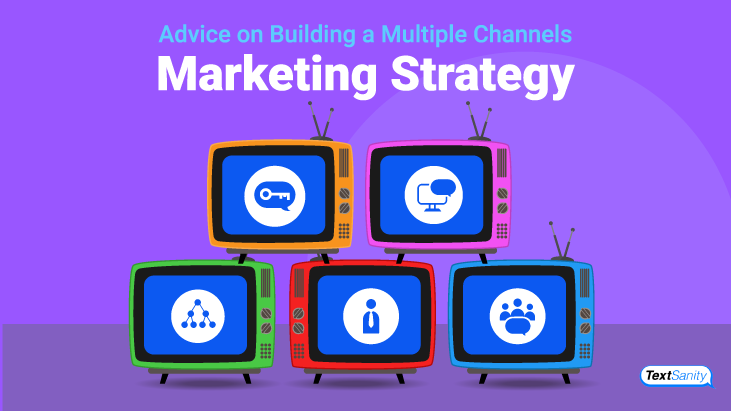Advice on Building a Multiple-Channels Marketing Strategy
Marketing through one channel is complex enough. Now, you’ve been asked to give advice on building a multiple-channels marketing strategy. Perhaps you’re not sure where to begin. It’s true that a multi-channel marketing strategy may take more time to develop. But, we can get you off on the right foot.
What is multiple-channel marketing?
Multiple-channel marketing is simply communicating with prospective consumers and existing customers through many different marketing channels. These channels are both online and offline, and they feed into one another.

Instead of running a traditional marketing campaign with a clear starting point and ending point, marketing is now a bit more complicated. Consumers do most of their shopping or product research online through various social media websites, forums, and product pages. Trying to figure out where you fit into these various channels starts with understanding the consumer.
Let’s start with consumer habits online. It’s not uncommon for people to move between tasks quickly. For example, in a 10-minute window, a consumer can move between sending a text, posting a picture on social media, and reading an email. Consumers do all this without a second thought or physically getting up. Convenience is king.
As always, the success of marketing depends on businesses learning to adapt to consumers lifestyles — specifically, fulfilling their wants and needs. Consumers can be everywhere all at once, and companies need to meet them there.
Types of channels used in multiple-channel marketing
The evolution of technology and marketing means that more consumers than ever want to be marketed to. This vastly changes how businesses and consumers interact with one another. Consumers welcome a text from their favorite brands, even commenting on business’ social media posts.
Although this interaction creates a broad marketing scope, it’s important to understand that your company doesn’t need to be on every marketing channel all the time.
Successful multiple-channel marketing occurs when a company identifies the channels their customers use. This understanding leads to seamless multi-channel experiences that the customer appreciates.
Multi-channel marketing is ideal for inbound marketing. Inbound marketing focuses on digital strategies that bring the consumer to your business. However, multi-channel marketing is good for outbound marketing strategies as well.
Types of channels
Here’s some of the most common marketing channels:
-
Print Marketing: Flyers, brochures, magazine ads.
-
Video Marketing: Using video to market or promote a business.
-
Social Media Marketing: Twitter, Instagram, Facebook, LinkedIn, etc. “Like and follow for more.”
-
SMS Marketing: Short messages to consumers via text.
-
Email Marketing: Email signatures, tags, banners, newsletters, etc.
-
Website Marketing: Blogs, FAQ page, About page, etc.
-
Word of Mouth Marketing: Your biggest fans getting the word out.
-
Search Engine Optimization (SEO) Marketing: Appropriate title tags, meta descriptions, keyword search results, etc.
-
Referral Marketing: Websites referencing your page or your company directory.
-
Pay-per-click (PPC) Marketing: Advertiser pays a publisher when the ad is clicked.
-
Influencer Marketing: A social media celebrity endorses a product or service.
You’re probably already using multiple channels for marketing, but it’s not the same as implementing an integrated multiple-channel marketing strategy. A well-thought-out marketing strategy means your website, social media posts, and other marketing channels are connected and pointing to each other.
Implementing a multiple-channel marketing strategy builds connections between your marketing channels. It gives consumers the experience they want and the growth your business needs.
How to use our advice on building a multiple-channels marketing strategy
First, implementing multi-channel marketing means establishing a goal of expanding your brand’s reach. This increases brand awareness in your target market. Understanding your target market helps you discern what channels accomplish this goal for your brand.

Second, determine the best message to resonate with your target market. Promote a deeper connection between your buyers and your brand.
Third, be consistent in your messaging across all channels. Stay on brand. Boost buyer confidence and trust with consistent messaging.
Fourth, promote engagement between businesses and consumers. Marketing is no longer solely about the distribution of information. It’s about interacting with consumers through content and feedback with platforms such as social media.
Fifth, remember to create the same experience across multiple channels. Narrow your focus to ensure customer satisfaction. Operate on fewer channels to improve the quality of the channel marketing if needed.
The benefits of multi-channel marketing
- Saving money: Because so many aspects of this strategy are digital, costs are surprisingly low.
- Data collection and improved analytics: Again, because so much of this strategy is done online, data collection is fairly simple, and improving your ability to analyze that data can teach you even more about your target market’s demographics.
- Improved customer perception: When your consumers see your consistent messaging across multiple channels, they become more loyal.
- Increased brand awareness: Be in the places your target audience spends their time increases their awareness of your brand.
- Additional engagement opportunities: Digital channels increase shareability which gives you a broader reach to potential buyers that may be unknown to you.
![]()
Marketing attribution challenges and models
It’s important to determine which aspects of your campaign are the most effective. This can be difficult to determine because of the essential multiple touch points with customers. Decide which interaction have the biggest impact and which aren’t necessary.

For example, a customer might opt-in to your SMS marketing campaign during their initial visit, and separately follow your brand on social media. If they come to your event, what brought them? Was it the text? Or was it the social media post?
Data such as open rates and click-through conversions are helpful, but marketing attribution is difficult to determine in some instances. Some attribution models to consider are:
- First interaction: This model gives all the marketing attribution credit to the first channel a prospect interacted with.
-
Last interaction: Conversely, this model gives all the credit to the last point of contact before a conversion.
-
Time decay: This model scales the credit across multiple points of contact. The last interaction gets the most credit, and each point of contact working backward to the initial interaction gets less credit.
-
Linear interaction: This is the equal opportunity model. All points of contact get equal credit for the conversion.
-
Position-based: In this model, the middle points get less credit than the last interaction point and the first interaction point.
Most companies use attribution models to determine how to budget marketing resources to individual channels. In other words, the channels seen as more successful and impactful on conversions are given more funds. Channels that underperform get less money and may be re-evaluated.
No one model is better than the other in attribution. It may be important to view attribution through multiple models before assessing performance.
Summary
Using one marketing channel isn’t enough anymore. More than likely, your business is already marketing through multiple channels to reach potential customers and increase conversions.
Giving customers consistency across various channels enhances their experience and improves your chances of success. Frequent evaluation of a channel’s marketing attribution helps your business effectively spend marketing dollars.
After determining the multiple channels you use in your marketing strategy, streamline the process for your consumers. The analytics will tell you what’s working, but if you’re doing it correctly, your customer will hardly notice the channel transitions.


